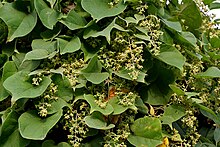
Back Malpighiales Afrikaans ملبيغيات Arabic ملبيغيات ARZ Malpighiales AST Malpigiyaçiçəklilər Azerbaijani Мальпігіякветныя BE-X-OLD Малпигиецветни Bulgarian Malpighiales BS Malpighials Catalan Malpighiales CEB
| Malpighiales Temporal range:
| |
|---|---|

| |
| Flower of Calophyllum inophyllum (Calophyllaceae) | |
| Scientific classification | |
| Kingdom: | Plantae |
| Clade: | Tracheophytes |
| Clade: | Angiosperms |
| Clade: | Eudicots |
| Clade: | Rosids |
| Clade: | Fabids |
| Order: | Malpighiales Juss. ex Bercht. & J.Presl[1] |
| Type genus | |
| Malpighia | |
| Families | |
| |
| Synonyms | |
|
Rhizophorales | |

The Malpighiales comprise one of the largest orders of flowering plants, containing about 36 families and more than 16,000 species, about 7.8% of the eudicots.[2][3] The order is very diverse, containing plants as different as the willow, violet, poinsettia, manchineel, rafflesia and coca plant, and are hard to recognize except with molecular phylogenetic evidence. It is not part of any of the classification systems based only on plant morphology. Molecular clock calculations estimate the origin of stem group Malpighiales at around 100 million years ago (Mya) and the origin of crown group Malpighiales at about 90 Mya.[4]
The Malpighiales are divided into 32 to 42 families, depending upon which clades in the order are given the taxonomic rank of family.[5] In the APG III system, 35 families were recognized.[1] Medusagynaceae, Quiinaceae, Peraceae, Malesherbiaceae, Turneraceae, Samydaceae, and Scyphostegiaceae were consolidated into other families. The largest family, by far, is the Euphorbiaceae, with about 6300 species in about 245 genera.[6]
In a 2009 study of DNA sequences of 13 genes, 42 families were placed into 16 groups, ranging in size from one to 10 families. The relationships among these 16 groups remain poorly resolved.[5] Malpighiales and Lamiales are the two large orders whose phylogeny remains mostly unresolved.[7]
Some examples of notable species include cassava, a tuber that is a major staple food crop in much of the world; the stinking corpse lily, which produces the largest known flower of any plant; the willows; flaxseed, an important food and fiber crop; Saint John's wort, a herb with a long history of medicinal uses; castor bean, the source of the infamous poison ricin; passionfruit, which produces an edible fruit and psychoactive flowers with a history of traditional medicinal uses; poinsettia, a common ornamental plant; the mangosteen; manchineel tree, one of the most toxic trees in the world; poplars, aspens and cottonwoods which are commonly used for timber — and many more.
- ^ a b Angiosperm Phylogeny Group (2009). "An update of the Angiosperm Phylogeny Group classification for the orders and families of flowering plants: APG III". Botanical Journal of the Linnean Society. 161 (2): 105–121. doi:10.1111/j.1095-8339.2009.00996.x. hdl:10654/18083.
- ^ Endress et al 2013.
- ^ Stevens 2020.
- ^ Susana Magallón & Amanda Castillo (2009), "Angiosperm diversification through time", American Journal of Botany, 96 (1): 349–365, doi:10.3732/ajb.0800060, PMID 21628193
- ^ a b Kenneth J. Wurdack & Charles C. Davis (2009), "Malpighiales phylogenetics: Gaining ground on one of the most recalcitrant clades in the angiosperm tree of life", American Journal of Botany, 96 (8): 1551–1570, doi:10.3732/ajb.0800207, PMID 21628300, S2CID 23284896
- ^ Alan Radcliffe-Smith. 2001. Genera Euphorbiacearum. Royal Botanic Gardens, Kew: Richmond, England.
- ^ Soltis, Douglas E.; Soltis, Pamela S.; Endress, Peter K.; Chase, Mark W. (2005), Phylogeny and Evolution of the Angiosperms, Sunderland, MA, USA: Sinauer, ISBN 978-0-87893-817-9
© MMXXIII Rich X Search. We shall prevail. All rights reserved. Rich X Search